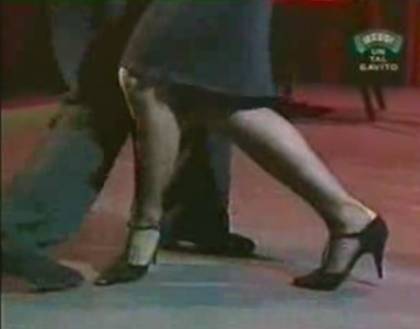The myth of Follow and Lead
17th December 2010
"Jumpin' without a parachute? Kinda dangerous, ain't it?" - Bugs Bunny
Introduction
(This is part of a series of "deconstructing the myth" articles - have a look at the other articles in the series for more information.)
Let's say I want to lead the follower to step backwards - what happens? Well (hopefully) I lead her to step backwards and she steps backwards. Simple.
This is probably the most complicated thing I've tried to explain, so I apologise if you need to read it a few times. I tried to find some videos, but unfortunately they tend to be cluttered with New Age psychobabble, particularly the one that went on to try and explain how to kill goats with your mind

*sigh*
The backstep
So, let's return to the backstep.

For the sake of clarity, let's say I lead it verbally. So I actually say "backstep", and she takes a backstep. There's no physical leading involved in this example.
The first problem if you actually try this out is that what happens now depends entirely on how well they can do a backstep.
Do this with a female teacher and a beginner guy and you'll get two very different backsteps. And to a very large extent there's not much you can do about this. It is possible in close embrace to use barridas to try and move them exactly where you want them to go, but there's a point beyond which you simply can't get enough resolution on the detail of movement - plus it's not really a practical solution in social dancing.
The second problem is that you say "backstep" and then the follower does it, ie you lead for a moment then wait while they do their part, as opposed to leading throughout the move.
Here's the complicated part
"I know this defies the law of gravity, but I never studied law!" - Bugs Bunny
Imagine you know how to lead a backstep perfectly. And imagine you have a follower who can follow a backstep perfectly. So you embrace and then you lead the backstep. Here's the paradox. You are leading every single moment of the step. Moreover you're leading every single nuance and detail of the step. And likewise the follower is following all that.
But it only works because the follower is doing it properly. If you did exactly the same thing on the beginner guy it wouldn't work.
Calculus...
There's a mathematical concept called Calculus - still reading? Good. If you know what it is, great. If you don't, here's all you need to know for this article.
Rather than measuring the lead and follow for the backstep in one piece (as in the verbal "backstep"), you can break it into smaller pieces eg
- Extend foot back
- Step back onto foot
And you could keep breaking it down into smaller and smaller pieces, until, as MsHedgehog puts it: "You could do the initial "weight transfer one toe at a time."
However the more pieces you break it into / more detail you add, the more things you both have to be in sync with.
(Calculus works on the idea that you keep going until the pieces are as tiny as can possibly be imagined).
In real terms
"For shame, doc. Hunting rabbits with an elephant gun. Why don't you shoot yourself an elephant?" - Bugs Bunny
So what does this mean in real terms? Well it's the difference between tango as a form of wrestling and what Einstein called "spooky action" where two electrons lead and follow perfectly, much to Quantum Physicists' confusion.
Simply put what you can lead and what you can follow depends on both of the people involved.
While "it's always the leader's fault" can be useful, sometimes this gets confused; what it means is that there are times when the perfect lead is the wrong decision - because your follower isn't going to respond with a perfect follow.
In that case you have to use the appropriate imperfect lead.
Conclusion
"Shhhhhhhh! I'm about to defy you". - Bugs Bunny
There's different schools of thought as to how this applies to perfectly following women if the man is using an imperfect lead...
But going back to Buggs' first quote, the woman is your parachute - be careful you know how well it's going to work before you jump!
~ Christopher O'Shea, 17th December 2010